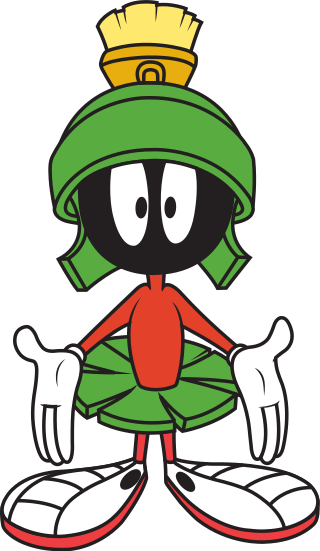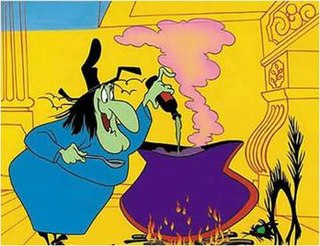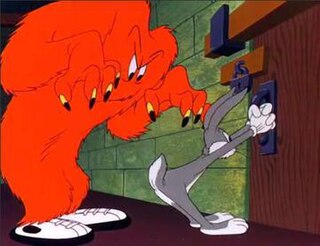Gossamer most commonly refers to:
Contents
- Fine spider silk used by spiderlings for ballooning or kiting
- Gossamer (fabric), very light, sheer, gauze-like fabric
Gossamer may also refer to:
Gossamer most commonly refers to:
Gossamer may also refer to:

Marvin the Martian is an alien race character from the Looney Tunes and Merrie Melodies series. He frequently appears as a villain in cartoons and video games, and wears a Roman soldier's helmet and skirt. The character has been voiced by Mel Blanc, Joe Alaskey, Bob Bergen and Eric Bauza, among others.

The Gossamer Albatross is a human-powered aircraft built by American aeronautical engineer Dr Paul B MacCready's company AeroVironment. On June 12, 1979, it completed a successful crossing of the English Channel to win the second Kremer prize worth £100,000.

Witch Hazel is an animated cartoon character in the Warner Bros. Looney Tunes and Merrie Melodies series of cartoons and TV shows. Witch Hazel is a fairy tale witch antagonist with green skin, a round figure, bulbous facial features, and a single tooth. The name is a pun on the witch-hazel plant and folk remedies based on it.
Leghorn may refer to:

Gossamer is an animated character in the Warner Bros. Looney Tunes and Merrie Melodies series of cartoons. He is a large, hairy, orange or red monster. His body is perched on two giant tennis shoes, and his heart-shaped face is composed of only two oval eyes and a wide mouth, with two hulking arms ending in dirty, clawed fingers. The monster's main trait is his uncombed, orange hair. He originally was voiced by Mel Blanc and has been voiced by Frank Welker, Maurice LaMarche, Joe Alaskey, Jim Cummings, Kwesi Boakye, Eric Bauza and currently Fred Tatasciore.

The MacCready Gossamer Condor was the first human-powered aircraft capable of controlled and sustained flight; as such, it won the Kremer prize in 1977. Its design was led by Paul MacCready of AeroVironment, Inc.
Rudolph or Rudolf may refer to:
Dope may refer to:
The Kremer prizes are a series of monetary awards, established in 1959 by the industrialist Henry Kremer.
Bryan Lewis Allen is an American self-taught hang glider pilot and bicyclist. He achieved fame when he piloted the two aircraft that won the first two Kremer prizes for human-powered flight: the Gossamer Condor and Gossamer Albatross. He later set world distance and duration records in a small pedal-powered blimp named "White Dwarf."
An albatross is one of a family of large winged seabirds.

Hair-Raising Hare is a Warner Bros. Merrie Melodies cartoon, released on May 25, 1946. It was directed by Chuck Jones and written by Tedd Pierce. It stars Bugs Bunny and features the first appearance of Chuck Jones' orange monster character "Gossamer".
A blueprint is a large-format reproduction, usually of an architectural or engineering plan.
Carrotblanca is a 1995 Looney Tunes cartoon short. It was originally shown in theaters alongside The Amazing Panda Adventure and The Pebble and the Penguin (internationally). It was subsequently released on video packaged with older Looney Tunes cartoons and was included in the special edition DVD, and later HD DVD and Blu-ray, releases of Casablanca, the film to which it is both a parody and an homage. At the time of release, WB did not own the rights to Casablanca. Like the original film, Carrotblanca is set during World War II.

The Solar Challenger was a solar-powered electric aircraft designed by Paul MacCready's AeroVironment. The aircraft was designed as an improvement on the Gossamer Penguin, which in turn was a solar-powered variant of the human-powered Gossamer Albatross. It was powered entirely by the photovoltaic cells on its wing and stabilizer, without even reserve batteries, and was the first such craft capable of long-distance flight. In 1981, it successfully completed a 163-mile (262 km) demonstration flight from France to England.

The Gossamer Penguin was a solar-powered experimental aircraft created by Paul MacCready's AeroVironment. MacCready, whose Gossamer Condor in 1977 won the Kremer prize for human-powered flight, told reporters two weeks in June, 1980 that "The first solar-powered flight ever made took place on May 18." The testing ground was at Minter Field outside of Shafter, California.
The Flight of the Gossamer Condor is a 1978 American short documentary film directed by Ben Shedd, about the development of the Gossamer Condor, the first human-powered aircraft, by a team led by Paul MacCready. The Academy Film Archive preserved The Flight of the Gossamer Condor in 2007.

A human-powered aircraft (HPA) is an aircraft belonging to the class of vehicles known as human-powered transport.
The HPA Toucan is a British two-seat human-powered aircraft built and flown by members of the Hertfordshire Pedal Aeronauts and was the first two-person human-powered aircraft to fly.